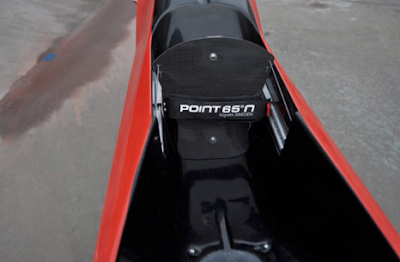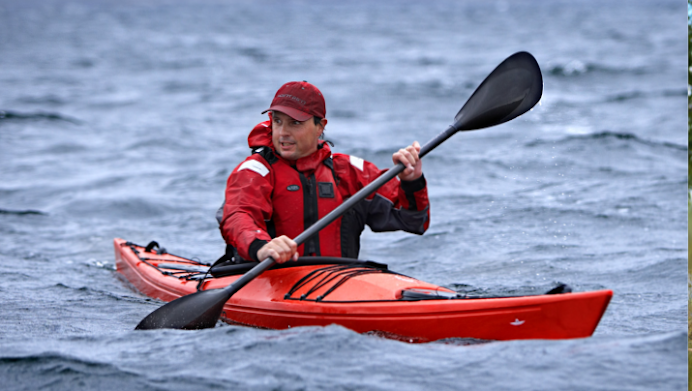Design statement on the Point 65 Bourbon Orca by its designer Magnus de Brito.
The Bourbon Orca’s unique design is the result of many ideas. Here I would like to explain the reason for its specific look and shape.
As an avid surf ski paddler, professional designer and product developer, it was hard to resist contemplating how I would like a ski to perform and look.
Prior to the development of the Bourbon Orca I paddled an Epic V10, a great ski. My hydro analysis of, among others, my Epic V10 indicated that it would be hard to design a faster ski than the ones winning all the races. So instead I focused on creating a surf ski that was just as fast but had other advantages that would enhance my performance.
So what else could I improve to increase speed? I identified two factors that would create a better, faster surf ski: less resistance going through waves and increased power.
Bow
First and foremost I wanted to increase the speed through waves as surf skiing is not performed on flat water. The most evident result of this quest is the reversed bow (or X-bow). This bow design was directly inspired by its namesake, the supply ship Bourbon Orca, which features the X-Bow. Naming the surf ski Bourbon Orca is a tribute to the ship. Modern F18 catamarans have also inspired me on the bow design.
http://www.youtube.com/watch?v=Mqcpe5au_7M
Why?
Because, by giving the bow maximum volume, as far down as possible, I could make the ski react faster to the waves. If you paddle the Bourbon Orca into a wave so that the bow dips just under the wave, it creates 10kg/22lbs more buoyancy compared to the Epic V10.

Bourbon Orca hits a wave.
In this way the bow follow the movements of the waves in a much better way, compared to a traditional ski, which meets the wave - with initially, relatively low volume. Only after a while does the traditional kayak build volume, lifting it out of sync with the wave and creating a loss off energy. In this video clip http://www.youtube.com/watch?v=Mqcpe5au_7M you can clearly see the supremacy of the Bourbon Orca’s reversed bow in contrast to the traditionally built ship.
The Bourbon Orca’s lower volume high up on the bow prevents it from lifting unnecessarily high, instead slicing the waves and taking the shortest route.
Stern
The stern has a low volume so that the kayak doesn't lift to early when surfing, making it feel shorter in chop. The volume builds rapidly up the length of the boat until it hits the widest spot only 240cm/94'' from the end of the stern. This provides lift when surfing.
Increasing power
As mentioned, I identified two factors that would increase speed: less resistance, which we have now resolved, and increased power.
So what could be done to increase power? The answer was to create better circumstances for the paddler to perform! I identified 5 areas where better circumstances could be created.
Stability
The highest priority was to increase stability without increasing resistance in the water. More stability enables the paddler to carry out an increased number of strokes with full draw/effect. I managed to tweak the Bourbon Orca into providing 25% more stability without compromising speed with more than a millesimal.
I recently witnessed a first time paddler taking the Bourbon Orca for a spin. Despite windy conditions he managed to paddle several hundred meters off shore, turn the kayak around and come back without falling in. He also tried a re-entry without any problems. This guy was sold! A common misconception is that stability is only achieved by giving the kayak a flat hull.
With the bourbon Orca I have proven the opposite by giving the kayak a cross section that is completely circular. This creates a good balance between some initial stability to minimize impact by small waves and chop and high secondary stability as a save when things start to go wrong. At the same time the wet area is minimal to minimize resistance.
Cockpit
The second factor is to create a cockpit that offers good contact while giving the legs and hips the possibility to work like in a racing kayak while offering comfortable lower back support to balance the kayak safely when surfing. The cockpit shape is hard to explain and it should be experienced.
Drainage
The third factor to increase power is to quickly drain the cockpit. There are two systems I have studied. The Andersen Bailer and the Bullet Scupper.
The Anderson Bailer is adjustable and efficient but creates a lot of resistance. When retracted the bailer creates minimal resistance but by constantly having to adjust the bailer, focus is taken from paddling which is less than ideal.

The inspiration for the scupper and the result

The Bullet Scupper flow analysis
The flow analysis above shows that the drainage is most efficient in the center. At it's sides there is slightly more turbulence. My "deBrito Bailer" has taken the efficient center section and extruded it towards the sides a couple of centimeters /0,78''. This makes it much more efficient while minimizing resistance. The bailer is equipped with a scupper plug so it can be shut when necessary.
The Paddle stroke
As the fourth improvement I have enabled the paddler to insert the paddle tighter to the boat allowing more power in the stroke. By shaving off the sides in this area I have achieved a hull that is 4cm/1.57'' thinner compared to, for example, the Epic V10.
Pedal system
The fifth and final area of innovation is that of the rudder pedals which allow the paddler to brace with the whole foot. It's a new way of steering the kayak. As a bonus it accommodates any foot size.
Leash with release
A separate safety innovation, developed in collaboration with Swedish surf ski paddler Paul Rosenquist, is the Magpaul Release Leash. By attaching one end of a line on the bow and the other with the leash, on a trigger mechanism in front of the pedal system, we achieve a safety feature if the kayak is snatched by a wave. A jerk at the trigger mechanism releases the line and alignes the kayak with the current. It also makes towing easier.

So what’s the result?
Instead of putting energy into bracing and re-entries while watching fellow paddlers disappear in front of me, I can now keep up with my more accomplished paddling companions.
Happy Paddling!
Magnus de Brito
Magnus de Brito has been involved in design projects for industry giants such as Porsche, Intelligent Sound, Pirelli Boats and Agipi Marine. Using computer science technology, Magnus was responsible for streamlining parts of the new generation Porsche Boxter 987, Carrera 997 and Carrera GT.
The Pirelli boat design won the prestigious 2009 Red Dot design award, “Best of the Best.” Working with Pirelli and Agipi Marine has given Magnus engineering experience in marine design technology – experience not usually available to kayak companies. The modular kayak Point 65 Tequila! won an honorary mention by Red Dot in 2010, ISPO's Brand New award and won Popular Science Magazines Best of what's New Award. The modular Martini was selected Swedish outdoor product of the year by the Swedish Outdoor Industry and was selected Playaks most interesting product at Kanumesse 2010.
Magnus was only 18 when he developed the first commercially viable wind surfing harness. He went on to earn his Master of Science degree in Design and Product Development from the University of Linköping,
Sweden. Throughout his career, his passion for water sports – and designing the best water crafts – has continued unabated. Now, at Point 65, Magnus is applying both his engineering skills and his kayaking expertise to our most challenging design projects including the new
XP series, the Tequila!, Martini and new models for 2011 HotShot and Bourbon Orca.







No comments:
Post a Comment